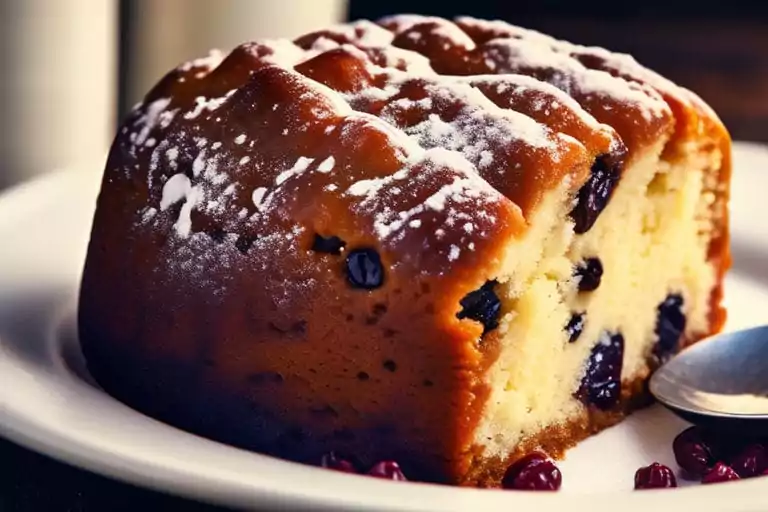Introduction to Spotted Dick
Historical Background
Once upon a time, in the bustling kitchens of 19th-century England, a dessert was born that would become a staple of British cuisine. Spotted dick, with its rich history and comforting warmth, has been a beloved treat for generations. This quintessential dessert, characterized by its “spots” of dried fruit and the enigmatic part of its name that has led to many a giggle, is more than just a sweet treat; it’s a slice of cultural heritage.
The origins of spotted dick are as intriguing as its name. The “spotted” part is straightforward, referring to the dried currants or raisins that dot the pudding, giving it a distinctive appearance. The “dick,” however, is shrouded in mystery. Some speculate it’s a corruption of the word “dough” or “pudding” from old English dialects. Regardless of its etymological origins, spotted dick has secured its place at the British table, evoking nostalgia and comfort with every spoonful.
Popularity in British Cuisine
Spotted dick isn’t just a dessert; it’s a cultural icon. Its popularity has endured through the ages, making it a fixture in cookbooks, restaurants, and homes across the UK. The dish’s simplicity, requiring only a handful of ingredients and a steaming process, belies the depth of flavor and satisfaction it delivers. It’s a testament to the timeless appeal of traditional English cooking, where simplicity and quality ingredients speak volumes.
Moreover, the pudding’s presence in British literature and media has cemented its status as a national treasure. From Charles Dickens to modern-day cooking shows, spotted dick has been celebrated and enjoyed in various forms, proving that good food transcends time.
In today’s culinary landscape, spotted dick continues to be revered, not just for its taste but for the stories it tells. It’s a dish that invites curiosity, laughter, and, most importantly, togetherness. As we delve deeper into the layers of this steamed pudding, we uncover not just the recipe for a dessert but the recipe for enduring cultural legacy. So, grab your spoon, and let’s dig into the history, preparation, and enduring charm of spotted dick, a dish that’s much more than its quirky name suggests.
The Recipe
Ingredients and Substitutions
Diving into the heart of spotted dick, the magic begins with its ingredients. Traditionally, this pudding is a symphony of simple yet flavorful components. At its core, you’ll find all-purpose flour, baking powder, a pinch of salt, and, of course, the “spots” – dried currants or raisins that give this dessert its characteristic look and name. Sweetening the mix, sugar is essential, with some recipes calling for the finer texture of caster sugar to dissolve more seamlessly into the batter.
But let’s not forget about the fat – traditionally, shredded beef suet is used, lending the pudding a unique texture and moisture. However, in our modern kitchen, we understand that suet might not be everyone’s cup of tea or readily available. Fear not! A good quality butter, chilled and diced, can step in as a substitute, ensuring that your spotted dick is just as moist and delightful, albeit with a slight twist on the traditional texture.
For those looking to adapt the recipe to dietary needs or preferences, there are options aplenty. Gluten-free flour blends can be used in place of all-purpose flour for those avoiding gluten. Similarly, for a vegan version, plant-based butter and milk can replace their animal-derived counterparts without compromising the pudding’s comforting essence.

Step-by-Step Cooking Guide
Now, onto the alchemy of turning these ingredients into the storied spotted dick. The process is a nod to the culinary traditions of yesteryear, where patience and a gentle touch were key to crafting the perfect dessert.
- Mixing the Dry Ingredients: Start by sifting together the flour, baking powder, and salt. Then, add your suet or butter, blending until the mixture resembles coarse breadcrumbs. This is the foundation of your pudding, where the magic of texture begins.
- Adding the “Spots”: Next, stir in the dried currants or raisins, ensuring they’re evenly distributed throughout the mix. These “spots” are not just for tradition; they add bursts of sweetness and texture that are integral to the pudding’s character.
- Binding the Mixture: Gradually add milk to the dry ingredients, mixing until you have a soft, cohesive dough. Here, the transformation begins, as the separate elements unite to form the body of your spotted dick.
- Steaming to Perfection: Spoon the batter into a greased pudding basin, cover it securely, and place it in a steamer or a pot of simmering water. The pudding needs to steam gently for about 1.5 to 2 hours, a slow process that infuses every bite with moisture and flavor.
- Serving with a Smile: Once cooked, turn out your spotted dick onto a serving plate and slice. Traditionally, it’s served with a generous drizzle of custard, a creamy companion that elevates the pudding from humble to heavenly.
Serving Suggestions
While spotted dick is a star in its own right, its versatility in serving options makes it a joy to present. The classic custard pairing is non-negotiable for purists, but why not explore a bit? A dollop of fresh cream or a scoop of vanilla ice cream can offer a delightful contrast in temperatures and textures, making each bite an adventure.
In the end, whether you stick to tradition or venture into modern adaptations, the essence of spotted dick remains unchanged. It’s a dish that brings warmth, joy, and a bit of cheeky humor to the table, inviting everyone to share in its rich history and delicious taste.
Cultural Significance
Cultural and Historical Context
Spotted dick is more than just a dessert; it’s a culinary artifact, weaving through the fabric of British history and culture. Its roots stretch back to the 19th century, a testament to the ingenuity of traditional English cooking. This pudding, with its curious name and comforting taste, has stood the test of time, evolving while maintaining its essence.
The cultural significance of spotted dick extends beyond its ingredients and preparation. It’s a dish that has witnessed the ebb and flow of British society, adapting to changes while remaining a symbol of culinary heritage. Its name, often a source of amusement and curiosity, reflects the rich tapestry of the English language and its evolution. Despite the giggles it may elicit, spotted dick commands respect on the dining table, celebrated for its simplicity and heartiness.
Spotted Dick in Modern Cuisine
In today’s culinary landscape, spotted dick holds its ground, a bridge between the past and present. While traditional recipes are cherished and preserved, contemporary chefs and home cooks alike have embraced the pudding, infusing it with their personal touches. This adaptability has introduced spotted dick to a new generation, ensuring its survival and relevance in a rapidly changing world.
Modern interpretations of spotted dick might play with the types of dried fruit used, incorporate new flavors, or adapt the dish to meet dietary restrictions, yet the soul of the pudding remains untouched. It continues to be a favorite in British pubs, restaurants, and homes, a comforting end to a meal or a sweet treat on a rainy afternoon.
Moreover, spotted dick has transcended borders, finding a place in the hearts of those far from the British Isles. Its story and unique charm have made it a subject of interest and affection globally, a small piece of Britain shared with the world.
The enduring popularity of spotted dick in modern cuisine is a testament to the power of food to connect us to our past, to each other, and to the stories that shape our identities. It’s a reminder that some dishes are more than just food; they are carriers of history, culture, and shared experiences, inviting us to explore and appreciate the richness of our culinary heritage.
Nutritional Information
In the realm of desserts, spotted dick holds its own with a unique blend of flavors and textures. However, for the health-conscious foodie or anyone curious about the nutritional content of this traditional British pudding, let’s delve into the details. Understanding the nutritional aspects can help you enjoy spotted dick in a balanced way, appreciating its place in a diverse diet.
Health Considerations
At its core, spotted dick is a carbohydrate-rich dessert, with the majority of its calories coming from flour, sugar, and dried fruits. The traditional use of suet or butter adds a significant amount of fats, contributing to the pudding’s dense and satisfying texture. While it’s a treat that should be enjoyed in moderation, there are ways to tweak the recipe for a lighter version. Substituting butter with a lower-fat alternative or reducing the sugar content can make spotted dick more accommodating to various dietary needs without sacrificing its comforting essence.
The dried fruits, primarily currants or raisins, provide a burst of natural sweetness along with dietary fiber, vitamins, and minerals. Opting for whole grain flour instead of all-purpose can also increase the fiber content, enhancing the pudding’s nutritional profile.
For those monitoring their intake, a single serving of spotted dick can vary in calories, but it’s generally considered a high-energy dessert. Pairing it with custard adds to the indulgence and the overall caloric intake, so portion control is key to enjoying this dish as part of a balanced diet.
Nutritional Breakdown
To give you a rough idea, a typical serving of spotted dick (without custard) can contain:
- Calories: Approximately 300-400 kcal
- Carbohydrates: 50-60g
- Fats: 10-15g (varies with the type of fat used)
- Protein: 5-7g
- Dietary Fiber: 2-4g
- Sugars: 20-30g (depending on the amount and type of sugar used)
These values are estimates and can vary based on the specific recipe and serving size. For those interested in exploring detailed nutritional information and making informed dietary choices, websites like Nutritionix offer comprehensive databases where you can track and analyze the nutritional content of countless foods, including traditional dishes like spotted dick.
Incorporating spotted dick into a healthy diet is about balance and moderation. By understanding its nutritional content and considering adjustments to the recipe, you can enjoy this delightful pudding while maintaining your dietary goals. After all, part of the joy of eating is finding harmony between nourishment and indulgence, allowing us to savor the flavors of the world with mindfulness and pleasure.

Common Questions
In the world of traditional British desserts, spotted dick certainly stands out, not just for its unique name but also for the curiosity it sparks. Here, we address some of the most frequently asked questions about this beloved pudding, shedding light on its preparation, variations, and how to enjoy it to the fullest.
For those looking to explore the rich world of British desserts further or seeking tips on perfecting their spotted dick recipe, resources like BBC Good Food provide a wealth of information, recipes, and cooking guides. Additionally, culinary history enthusiasts can delve into the dessert’s background and its place in British culture through articles and resources available at Historic UK, enriching the cooking and dining experience with historical context and stories.
Spotted dick remains a cherished dish in the panorama of British cuisine, a symbol of culinary tradition and a reminder of the simple pleasures of homemade desserts. Whether you’re a seasoned chef or a curious newcomer to British cooking, the journey through the history, preparation, and enjoyment of spotted dick is a delightful exploration of taste, tradition, and the ties that food has to culture and memory.
